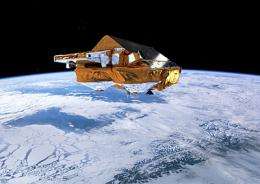CryoSat-2 ready for launch

Following yesterday's launch dress rehearsal and the debriefing today, the Russian State Commission has given the go-ahead to launch ESA's ice mission tomorrow at 15:57 CEST.
Today's go-ahead marks the last milestone along the road to launch the long-awaited CryoSat-2 satellite. By measuring the tiny variations in the thickness of ice floating in the polar oceans and changes in the vast ice sheets on land, the mission will provide scientists with hard evidence on the speed at which ice is diminishing.
This information will lead to a better understanding of the role ice plays in the Earth system and climate change.
"After the loss of the original CryoSat in 2005, we are extremely happy to have reached this point after four years rebuilding the satellite, including a number of improvements on the original," said Richard Francis, ESA's Project Manager, speaking from ESA's European Space Operations Centre (ESOC) in Darmstadt, Germany.
"We are now very much looking forward to a successful launch and then delivering the data the scientific community so badly needs to build a true picture of what is happening in the fragile polar regions."
The go-ahead to launch follows yesterday's dress rehearsal of the countdown at ESOC and Baikonur. This 9-hour exercise was a full simulation of the launch procedure to ensure that the all-important operation and communication sequences and procedures are in place for tomorrow.
The ground stations in Kenya, Antarctica, Norway and Sweden were also connected via voice loop and data lines, making the operation as realistic as possible. The North American Aerospace Defense Command (NORAD), who provides further support, was also involved.
Preparations for launch continued today with a 'pre-launch briefing' at ESOC to ensure everyone involved in the launch and critical early operations is fully informed of the latest status of the satellite and the Dnepr launcher.
It was attended by the engineers, scientists and operations experts who will be 'on console' in various control rooms or sitting at specialised workstations or network centres at ESOC starting some nine hours before launch.
CryoSat-2 will be launched on a Dnepr rocket from an underground silo at the Baikonur Cosmodrome in Kazakhstan at 15:57 CEST (13:57 UT).
Provided by European Space Agency



















